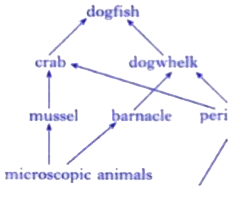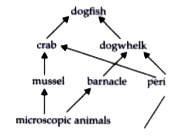Study carefully the food chain given below :
Food chain : wheat → rat → snake → hawk
To which of the two consumers. Snake or hawk, will more energy (per cent) be available and why ?
To determine which consumer, the snake or the hawk, will have more energy available to it in the given food chain (wheat → rat → snake → hawk), we can follow these steps:
1. Identify the Trophic Levels:
- In the food chain, wheat is the producer (1st trophic level).
- The rat is the primary consumer (2nd trophic level).
- The snake is the secondary consumer (3rd trophic level).
- The hawk is the tertiary consumer (4th trophic level).
2. Understand the 10% Energy Transfer Rule:
- According to the 10% rule, only about 10% of the energy from one trophic level is transferred to the next level. This means that as we move up the food chain, the amount of energy available decreases.
3. Calculate Energy at Each Trophic Level:
- Let's assume the total energy produced by wheat (the producer) is 100 units.
- Energy available to the rat (primary consumer) = 10% of 100 = 10 units.
- Energy available to the snake (secondary consumer) = 10% of 10 = 1 unit.
- Energy available to the hawk (tertiary consumer) = 10% of 1 = 0.1 units.
4. Compare Energy Availability:
- From the calculations, we see that the snake has 1 unit of energy available, while the hawk has only 0.1 units of energy available.
5. Conclusion:
- Therefore, the snake has more energy available to it compared to the hawk.
Final Answer:
The snake will have more energy (per cent) available than the hawk because it is at a lower trophic level, where more energy is retained according to the 10% rule.
- In the food chain, wheat is the producer (1st trophic level).
- The rat is the primary consumer (2nd trophic level).
- The snake is the secondary consumer (3rd trophic level).
- The hawk is the tertiary consumer (4th trophic level).
- According to the 10% rule, only about 10% of the energy from one trophic level is transferred to the next level. This means that as we move up the food chain, the amount of energy available decreases.
- Let's assume the total energy produced by wheat (the producer) is 100 units.
- Energy available to the rat (primary consumer) = 10% of 100 = 10 units.
- Energy available to the snake (secondary consumer) = 10% of 10 = 1 unit.
- Energy available to the hawk (tertiary consumer) = 10% of 1 = 0.1 units.
- From the calculations, we see that the snake has 1 unit of energy available, while the hawk has only 0.1 units of energy available.
- Therefore, the snake has more energy available to it compared to the hawk.
The snake will have more energy (per cent) available than the hawk because it is at a lower trophic level, where more energy is retained according to the 10% rule.
Topper's Solved these Questions
Similar Questions
Knowledge Check
Identify the following food chain: Dead animal Blow fly maggots → Common Frog → Snake
AGrazing food chainBPredator food chainCParasitic food chainDDetritus food chainGrass-insect-frog-snake-hawk. In this food chain the secondary consumers are :
AinsectsBfrogCsnakeDgrassIdentify the possible link ''A'' in the following food chain : Plant → insect → frog → ''A'' → eagle:
ArabbitBwolfCcobraDparrot
Observe the food web and answer the questions given below -

Why do all food chains start with plants?
View SolutionIn a food chain of frogs, grass, insects and snakes assign trophic level to frogs. To which category of consum -ers do they belongs to ?
View SolutionRewrite the food chain given below in the correct sequence.
i. Insect →Hawk → Snake→Frog→Grass
ii. Birds →Zooplanktons →Phytoplanktons→ Small Fishes→ BigFishes
View SolutionIdentify the correct type of food chain.
Dead animal → Blowfly maggots → Common frog → Snake:
View SolutionIdentify the possible link ''A'' in the following food chain
Plant → insect frog → ''A'' → Eagle
View Solution


